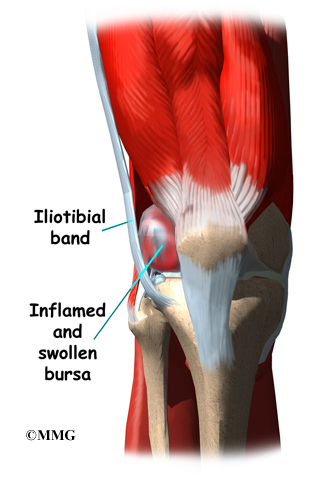 ITB syndrome: for the newbies out there, pain at the lateral (outer) boarder of ones thigh is usually diagnosed or referred to as "ITB Syndrome."
What happens under the microscope: Looking at a cadaver with an ITB disorder, you see the muscle fiber buckling under the excessive loading (it looks wavy) and the fascia is whiter under the areas of increased stress load, causing increased density of fibers here and there... In basic terms, what is overused becomes aggravated and then reinforced with a stronger tissue...
Physics added to the picture: why does the fascia become wavy? With excessive loading over five minutes in duration, the tissue undergoes the phenomenon of plasticity.. meaning that as a constant pressure (over time and distance) is applied to the tissue, it will stretch permanently, forming these dented-in appearing (and feeling) regions. As the
ITB syndrome: for the newbies out there, pain at the lateral (outer) boarder of ones thigh is usually diagnosed or referred to as "ITB Syndrome."
What happens under the microscope: Looking at a cadaver with an ITB disorder, you see the muscle fiber buckling under the excessive loading (it looks wavy) and the fascia is whiter under the areas of increased stress load, causing increased density of fibers here and there... In basic terms, what is overused becomes aggravated and then reinforced with a stronger tissue...
Physics added to the picture: why does the fascia become wavy? With excessive loading over five minutes in duration, the tissue undergoes the phenomenon of plasticity.. meaning that as a constant pressure (over time and distance) is applied to the tissue, it will stretch permanently, forming these dented-in appearing (and feeling) regions. As the - Over striding (90% of runners)-The foot should land just below your sternum with 2/3 of your stride behind you.The vertical shear force behind the patella is increased
- Heel striking-Increased forces vibrating up the landing heel, A "breaking" effect. Instead land midfoot, aiming for slightly behind the ball of your foot.
- Flat Arches (pronated feet) Over-stretch phenomena of the ligaments and fascia of the bottom of the foot. Often caused by standing in archless footwear. The muscles of the foot tire and the weight of the body stretches the fascia/ligaments. (Via the element of plasticity) often to the point of pain/scarring: plantar fascitis!
- Weak Hip Musculature (external rotators/abductors)- The muscles that hold the hips steady as you run can fatigue or simply not fire. The hip "sags" vertically, causing the knee to move medially (toward centerline). A twisting motion is placed into the knee: knee pain/swelling. The ITB is over stretched as the knee moves medially. Increases the stress on the ITB leading to tissue overloading aligned failure
- Trail Running Technique/Gait Modifications for Rocky Terrain: Most trail runners modify their gait for difficult terrain. The most common modification: a scissor gait. (The foot prints land on the same line which is in the center of the patients' body. This runner usually with their knees close together as well (also stresses the ITB)
Changing these stressors on the knee/ITB region will reduce the amount of biomechanical overuse on the region.
How to solve this problem?
- Have your gait videotaped from the side, the back, and the front so you can see if you are doing any of the above (I do so at my clinic, you can use a good camera and upload it onto your computer. If you are having trouble visualizing it, you can put it into paintbrush and draw the lines in).
- Check your orthodics (which may be old and not work anymore...) to make sure you have a level landing bed so your foot lands with a perfect arch, reducing the medial pull on the knee which comes from a collapsing arch.
- Strengthen the muscles creating a natural arch (Posterior Tib.)
- Do drills training your knee to stay over your second toe (not letting it fall inward or reside over the fifth toe) and while you are at it, do drills to fix your gait mistakes found in the video... a whole different topic!
- Strengthen your Glute Medius and Minimus by doing hip raises, which should be done after your run.. some runners don't see it on videotape until the muscles are fatigued (like the midway point in your marathon/15k).
- Practice running with your stance wide enough that your foot placement does not overlap on trail runs/rocky terrain runs.
Good Luck Guys- hope this helped! As usual, I am happy to give gait ideas to the needy =) Recommended text: Jack Cady (PT), Efficient Running (http://www.stridemechanics.com/) , Chi Running, Danny Dreyer (http://www.amazon.com/ used books)
Happy Trails! -Doc Lisa

